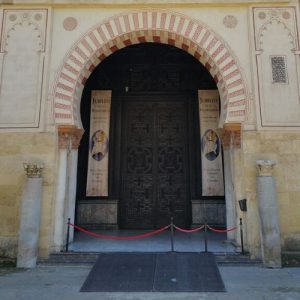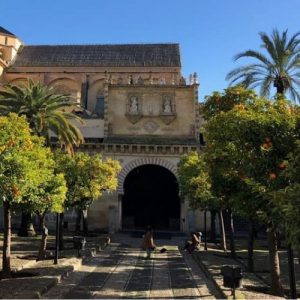The accessible Mezquita Mosque-Cathedral is a must-see when visiting Córdoba. In this comprehensive guide, you find everything you need to know about the Mezquita in Córdoba and its accessibility. The historic complex has a long history that you can spot in every aspect of the building. ‘Mezquita’ is Spanish for ‘mosque.’ This name refers to the function of the building before it became a cathedral. Both the historic center of Córdoba and the Cathedral are on the UNESCO World Heritage List.
Click on the subjects listed here, to find your way through the guide more easily:
- About the Mezquita
- Visigoth Basilica of San Vicente
- Original mosque of Abd al-Rahman I
- Expansion of Abd al-Rahman II
- The intervention of Abd al-Rahman III
- Expansion of Al-Hakam II
- Mihrab
- Expansion of Almanzor
- Royal Chapel
- Parroquia del Sagrario
- Bell Tower
- The main Chapel, choir and transept
- Patio de Los Naranjos
- Significant doors
- Accessibility of the Mezquita
- Wheelchair Accessible Tours in Córdoba
- How to get there
- Ticket information
About the Mezquita
The accessible Mezquita is an extraordinary complex. It is classified as a Mosque-Cathedral. At first, it served as a mosque; later, it became a cathedral. To this day, the Cathedral is being used and is almost completely wheelchair accessible. Construction started in the eighth century. Even though the structure has a turbulent history, it is a pleasure to walk/roll around in it.
The 860 columns in the complex leave a big impression, as well as the many other sights you find in the building. The mosque consists out of multiple styles. The reason for this is that different monarchs added parts over time.
Inside the cathedral, you find a lot of artistic masterpieces. These were meant to bring God closer to the people and make His message clearer. The Cathedral became a center of cultural expression in the city of Córdoba. Some of those masterpieces are the Mural painting of the Baptism of Jesus, The Incarnation, and the Processional custody of Corpus Christi. Moreover, you find the Altarpiece of Ieshu Verde and Saint Nicholas of Bari, the Pax-board of the Marquis de Comares, and The Holy Supper. Other pieces are the Main Altarpiece, Saint Eulogius, the Altarpiece of Our Lady of the Rosary, Saint Sebastian, Saint Michael, the Choir stalls, Saint Raphael, and much more.



Visigoth Basilica of San Vicente
Underneath the original mosque of the accessible Mezquita, they found remains of the Basilica of San Vicente. Excavations in the basement led to discovering walls and floors of the Visigoth Basilica of San Vicente under the original chapel of Abd al-Rahman I. One of the most important finds here are the mosaics. They match with the flooring of a room from the original Visigoth Basilica. Besides that, archeologists found an inscription that describes where the used materials came from. Because of these findings, the construction probably started as early as in the 6th century.
Original mosque of Abd al-Rahman I
Abd-al-Rahman I built the Primitive Mosque in the 8th century with the intention of it being a sign of power. The architecture has clear Hispanic-Visigothic influences. This phenomenon makes sense since the architects used materials and columns of the Visigothic Basilica of Sant Vicente. It is a beautiful place that deserves your attention during your visit to Córdoba.
This part of the Mezquita is wheelchair accessible. A ramp is placed at the entrance for easy access.


Expansion of Abd al-Rahman II
Abd al-Rahman II started expanding the complex during the first half of the 9th century as an answer to the demographic development that was happening in Córdoba during that time. The original mosque of Abd al-Rahman I already had eleven cores, but here, they added eight more. A notable highlight of this building is the use of sediment materials that define the character of the structure.
The intervention of Abd al-Rahman III
Expansions under Abd al-Rahman III did not take place. However, he did leave a distinct impact on the building by making some adjustments in the first half of the 10th century. On the Blessing Arch or the Door of the Palms, archeologists found an inscription that describes how the emperor worked on the façade of the chapel overlooking the patio. This intervention included overlapping of the original façade with horseshoe arches. Besides that, he also constructed the new minaret.


Expansion of Al-Hakam II
You recognize the contribution of Al-Hakan II from the middle of the 10th century by the brightness, innovation, and creativity of the building. These aspects represent how Córdoba developed at that time. The Monarch used the existing building as a starting point and turned the room into an example of universal architecture. He introduced various new features, such as a beautiful concept that uses marble, plant motifs, and mosaics. Al-Hakan II added twelve new segments to the complex. Most of the attention in this part gets drawn to the Mihrab because it is such a breathtaking feature.
Mihrab
A mihrab is an Islamic prayer nook in the wall of a mosque that shows the direction of prayer, the qibla. At the Mezquita, you find it in the central area that was modified by Al-Hakam II. Besides being an indication for the direction of prayer, it is also the area where most visitors direct their attention. The Mihrab is covered in brilliance, which leaves you speechless.



Expansion of Almanzor
The development of Almanzor took place at the end of the 10th century. He wanted to show his power as a dictator but did not want to undermine previous Rulers. That is why he did not demolish anything. The architects copied Al-Hakam II’s structure when adding eight new centers. The result of this is that the building gained unity and a feeling of discipline. The most important aspect of Almanzor’s contribution was space: he constructed a large and proportioned complex.
Royal Chapel
The accessible Cathedral of Córdoba is proof of how the monarchs of Spain wanted to present their religiosity, power, and wealth, and so is the Royal Chapel. The highlight of this space is the elaborate decorations. It is a striking combination of Arab and Moorish styles. Unfortunately, the Royal Chapel is not accessible to the public. Keep in mind that the architecture of this building influenced the grandeur of Córdoba during this period. It became the new architectural style for the local elite.


Parroquia del Sagrario
The place where the Parroquia del Sagrario is currently situated originally had other functions. It used to be a chapel and later a library. Since the last part of the 16th century, this site has been an essential sanctuary of the Cathedral. Your attention immediately goes to the walls since they are covered in magnificent murals.
Bell Tower
When the first mosque was built, the bell tower was a Muslim minaret. But after the Christians conquered the complex, they made a bell tower out of it. That tower existed until the 16th century when an earthquake affected the stability of the building, and it was torn down. After the earthquake, they built a new one and added multiple aspects. Today, it is the most prominent tower in the city with its 54 meters.



Villaviciosa Chapel, choir and transept
The Villaviciosa Chapel is the original main chapel of the accessible Mezquita complex. Moorish artisans built it in 1371. The complexity of this part of the building is a real piece of art. It provides a perfect combination of Gothic, Renaissance, and Mannerism art. In the 16th century, a project started that changed the whole chapel. The first architect focused on creating Gothic vaults on one side of the choir. Later, his son continued his work by, among other things, raising the transept walls. He strengthened them with buttresses. The last architect finalized the choir and transept by giving them spectacular ceilings.
Patio de Los Naranjos
The Orange Trees Courtyard, or Patio de Los Naranjos, is the first thing you see when entering the complex. Its functions and forms have changed over the years. When the Mezquita served as a mosque, rulers used the patio as a place for ritual purification and Muslim prayer. Once it turned into a cathedral, the courtyard became a sacred area for Catholic ceremonies. The difference in form can be found, for example, in the prayer hall. During the Muslim period, this was an open area. When the Christians took over, they closed the room. In the 16th century, the patio changed the most. The former bishop decided the place should be used as a garden. He planted orange trees, palms, and cypresses in straight rows as if the columns from inside continued.
This part of the Mezquita is accessible by wheelchairs through the Door of the Deans – this is the only accessible entrance to the complex.




Significant doors
The Door of the Deans
The Door of the Deans is one of the entrances to access the inside of the Patio de Los Naranjos. This old gateway dates back to the first mosque, built by Abd-al-Rahman I, so it is one of the older doors. This entrance got his name due to the function of the dean in ancient times. It consisted of taking care of the church while the bishop was away. When a dean took on this responsibility, he would be invested as the new dean in an official ceremony. Through the Door of the Deans, he entered the cathedral together with members of the Cathedral Chapter. This event gave the entrance its name.
The Door of the Palms
The second door is the Door of the Palms. Its original name is the Arch of the Blessings and gives you access to the original mosque. This doorway is named after its use in ceremonies. Each new royal got the blessing of the royal banner by walking through the door. For easy access, they placed a ramp over the steps to make this part wheelchair accessible.
The Door of Forgiveness
The third gate, the Door of Forgiveness or la Puerta del Perdón, is a beautiful gateway with big doors of almost ten meters. On the door, you see the remains of mural paintings that represent Our Lady of the Assumption, Saint Michel, and Saint Raphael. This doorway leads you into the Patio de Los Naranjos.
The Door of Saint Catherine
The fourth door that is worth mentioning is the Door of Saint Catherine or la Puerta de Santa Catalina. It received its name because of the nearby convent of Santa Catalina. When going through this gateway, you also arrive on the Patio de Los Naranjos. On the walls of this gateway, there are also mural paintings found that represent Saint Catherine, Saint Acisclus, and Saint Victoria.



Accessibility of the Mezquita
There are multiple entrances to get inside the accessible Mezquita. However, the only accessible one is called the door of Deans or la Puerta de Los Deanes. It is the closest one to enter the first mosque, and it is at the beginning of the visit. You find this entrance on Torrijos street.
Once you are inside, you find yourself at the Patio de Los Naranjos. From here, you go through the Door of Palms to access the interior of the cathedral. A ramp is placed over the steps to give you easy wheelchair access.
Inside the cathedral, there are ramps placed wherever needed to give you easy access to all parts of the complex. However, the choir is not wheelchair accessible.
Along the route, supports and benches are placed, in case you need a break. Besides that, there is enough space to maneuver with a wheelchair.
Inside of the exposition halls, the minimum height of the exhibition cabinets is 90 cm.
The complex has wheelchair adapted toilets with enough space, a folding support bar, and free space under the sink for easy use.
The Mezquita itself is very wheelchair accessible. However, the area around the complex is mostly cobbled and can be challenging to maneuver.



Wheelchair Accessible Tours in Córdoba
The wheelchair-accessible city of Córdoba in Andalucía has a lot to offer. Do you want to see this beautiful city for yourself? We provide the perfect tours for you. Experience the accessible city together with a private licensed guide that picks you up at your accommodation.
How to get there
The wheelchair-accessible Mezquita is situated in the heart of Córdoba. Depending on your starting location, it is accessible by foot, but you can also take public transport. Via bus 3 and 12, at the bus stop ‘Puerta del Puente”, you can reach the accessible Mezquita. 98% of the busses used by Aucorsa, the bus company in Córdoba, are wheelchair accessible. There is a ramp available for wheelchair users and inclination that reduces the height between the bus and the ground. Every bus stop has a personalized QR-code. By scanning this, you receive more information about the stop.
There is also the possibility to reserve adapted transport through us, if necessary. Click on our transfers for more info.
The address of the complex is Calle Cardenal Herrero, 1, 14003 Córdoba, Spain.
Ticket information
Depending on what you want to see, you can opt for different kinds of tickets. For almost all the tickets, reduced prices are available for people with disabilities when presenting official documents. The different types of tickets give you entrance to the Mosque-Cathedral, a night visit to The Soul of Córdoba, a visit to the Mosque-Cathedral and the Bell Tower, a visit to the Bell Tower, and a visit to the Route of the Fernandina Churches.
When are you planning your next visit? The majestical, accessible Mezquita should defenititely be on your list.
Get inspired, continue reading
- Wheelchair Accessible Cultural Highlights of Spain
- Explore Disabled Accessible Travel’s destinations
- Accessibility guide of Acropolis and Museum
- Disabled Accessible Travel Expands Accessibility Services with Launch of Mobile App ‘accessaloo’
- Wheelchair Accessible Transfers
- Accessibility of St. Petersburg
- Mobility Equipment Rentals
- 7 Wheelchair-friendly Restaurants in Barcelona
- Everything You Need To Know About Tipping In Europe
- Nova Icaria And 4 Other Accessible Beaches Barcelona Has To Offer
- Accessibility guide Alhambra
- Accessible Train Tickets in Spain – Renfe
- Accessible islands in Europe
- Top 8 Accessible Destinations in Europe
- Accessibility guide Parliament Budapest
- A useful guide to European toilet keys






